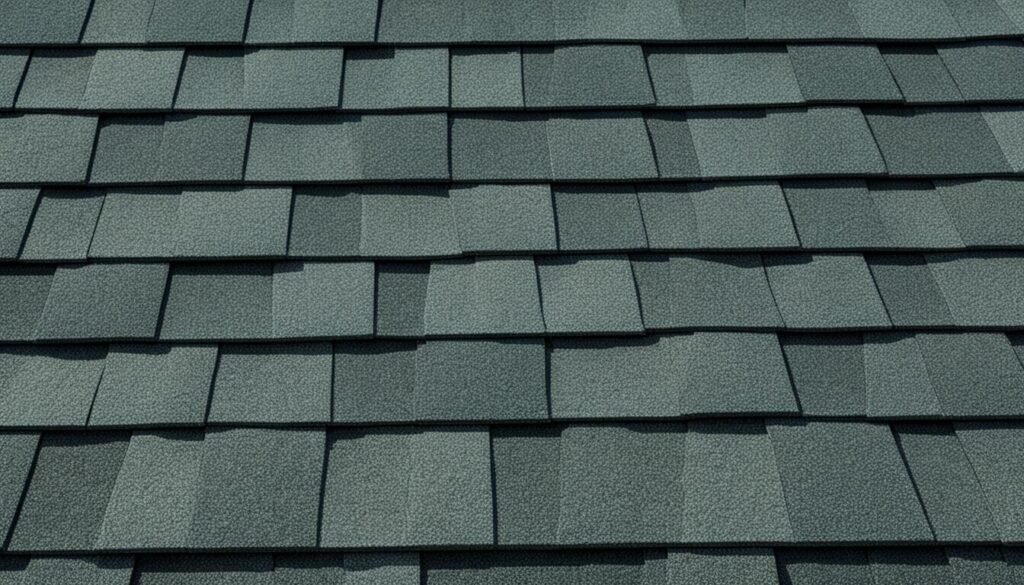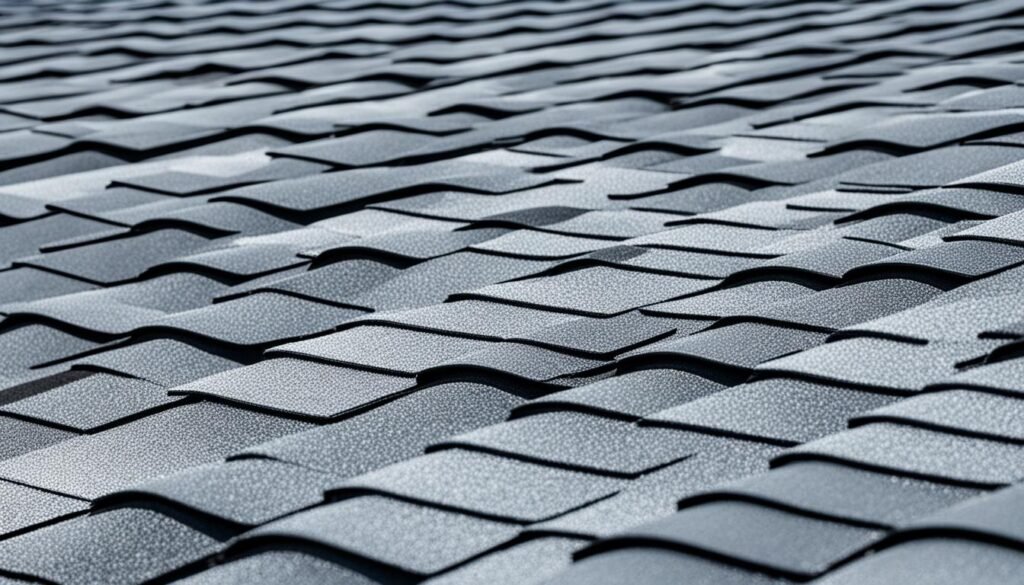Did you know that the choice of roof shape can have a significant impact on cost-effectiveness and durability? Finding the right balance between affordability and longevity is crucial when it comes to selecting a roof for your home.
In this section, we will explore the cheapest roof shapes and discuss their cost-effectiveness and longevity. We will also delve into different affordable roofing designs and budget-friendly options, equipping you with the knowledge to make an informed decision for your home.
Key Takeaways:
- Choosing the right roof shape is important for cost-effectiveness and durability.
- Understanding the different affordable roofing designs can help you make an informed decision.
- Considering budget-friendly options can save you money without sacrificing quality.
- Longevity should be a key factor when selecting a roof shape.
- Make sure to weigh the pros and cons of each roofing option before making a decision.
Cheapest Roofing Materials
When it comes to affordability, there are several roofing materials that stand out. Understanding the pros and cons of each option can help you make an informed decision for your home. Let’s explore the most cost-effective roofing materials on the market:
1. Asphalt Shingles
Asphalt shingles are the most common and cheapest roofing material available. They offer a wide range of styles and colors, making them versatile and suitable for various architectural designs. Additionally, asphalt shingles are relatively easy to install, reducing labor costs. Despite being a budget-friendly option, they provide decent durability and can last up to 20-30 years with proper maintenance.
2. Metal Roofing
Metal roofing is gaining popularity due to its longevity and durability. Although the initial cost may be higher than asphalt shingles, metal roofs can be more cost-effective in the long run. Metal roofs are known for their resistance to extreme weather conditions, including high winds, heavy rainfall, and snow. With a lifespan of 40-70 years, they rarely require replacement, resulting in long-term savings.
3. TPO Roofing
TPO (Thermoplastic Olefin) roofing is a relatively new option, particularly suited for flat roofs. It offers excellent resistance to UV radiation, chemicals, and punctures, ensuring a longer lifespan compared to other roofing materials. TPO roofs can last between 20-30 years, making them a cost-effective choice for commercial and residential buildings.
4. Concrete Tile Roofing
Concrete tile roofing is known for its durability and ability to mimic the appearance of more expensive materials like clay tiles. While it provides excellent aesthetics and protection, concrete tile roofing tends to be more costly than asphalt shingles. However, its longevity of up to 50 years can compensate for the initial investment.
5. Clay Tile Roofing
Clay tile roofing is often associated with timeless beauty and elegance. It offers natural insulation, exceptional durability, and a lifespan of 50-100 years. However, clay tile roofing tends to be one of the more expensive options, making it better suited for homeowners seeking long-term investments with a striking aesthetic appeal.
Choosing the right roofing material ultimately depends on your budget, desired lifespan, and aesthetic preferences. Consider consulting with a professional roofing contractor who can provide expert advice tailored to your specific needs.
“The cheapest roofing materials might not always be the most affordable choice in the long run. Consider the lifespan, maintenance requirements, and environmental factors when making your decision.” – Roofing Expert
| Roofing Material | Cost | Lifespan | Aesthetic Appeal |
|---|---|---|---|
| Asphalt Shingles | Low | 20-30 years | Moderate |
| Metal Roofing | Moderate | 40-70 years | Modern |
| TPO Roofing | Low/Moderate | 20-30 years | Sleek |
| Concrete Tile Roofing | Moderate | Up to 50 years | Versatile |
| Clay Tile Roofing | High | 50-100 years | Elegant |
If you’re unsure about which roofing material is best for your budget and needs, consider contacting a reputable roofing contractor who can provide personalized recommendations.

Factors Affecting Cost
When determining the cost of a roof, it’s important to consider various factors beyond just the roofing material. These factors can significantly impact the overall cost and effectiveness of your roof. Understanding these components will help you make informed decisions and ensure you are getting the best value for your investment.
1. Roof Deck
The roof deck serves as the foundation for the roof covering. It is essential to have a sturdy and well-built roof deck to ensure the longevity and structural integrity of your roof. A solid roof deck might require additional measures during installation, which can impact the overall cost.
2. Underlayment
Underlayment is a critical layer between the roof deck and the final roofing material. It acts as a protective barrier, preventing water infiltration and enhancing the roof’s durability. Using high-quality underlayment can add to the overall cost but ensures greater protection and longevity of your roof.
3. Flashing/Drip Edge
Flashing and drip edge are components that help direct water away from vulnerable areas of the roof, such as joints, intersections, and edges. Proper installation of flashing and drip edge is essential for preventing water damage and increasing the lifespan of the roof. Investing in quality materials and professional installation might increase the cost but ensures long-term protection against leaks.
4. Ventilation
Roof ventilation plays a vital role in maintaining the condition of your roof and preventing issues such as moisture buildup, mold, and thermal damage. Proper ventilation helps regulate temperature, reduce energy costs, and extend the life of your roof. Consider consulting with a roofing professional to ensure your roof has adequate ventilation based on your specific climate and needs.
5. Easy DIY Roofing
Another factor that affects the cost of your roof is the ease of DIY roofing. If you have the skills and experience to tackle roofing projects on your own, you can potentially save on labor costs. However, it’s crucial to assess the complexity of the job and consider the risks involved. For more complex roofing tasks or if you lack experience, hiring a professional roofing contractor might be a safer and more cost-effective option.
By considering these factors – roof deck, underlayment, flashing/drip edge, ventilation, and easy DIY roofing – you can get a better understanding of how they contribute to the overall cost and effectiveness of your roof. Making informed choices throughout the roofing process will ensure you have a durable, long-lasting roof that meets both your budget and performance requirements.

Conclusion
When it comes to choosing the cheapest roof shape for your home, asphalt shingles are typically the most affordable option. However, it’s important to consider other factors such as longevity, maintenance requirements, and aesthetics.
By working with a reputable residential roofing company or commercial roofing company, you can ensure that your roof is installed properly and that you receive the best value for your budget. These professionals have the knowledge and expertise to guide you through the different roofing options, including the cheapest ones, and help you make an informed decision.
Furthermore, these roofing companies can also assist with roof repairs and offer roof financing options if needed. Whether you need a new roof installation or minor repairs, they can provide expert services to keep your roof in top condition.
Contact a trusted roofing company today to discuss your needs and find the best solution for your home. With their help, you can have a cost-effective and reliable roof that will provide long-lasting protection for years to come.
FAQ
What is the cheapest roof shape?
The cheapest roof shape is typically asphalt shingles.
What are cost-effective roof shapes?
Cost-effective roof shapes include asphalt shingles, metal roofing, TPO roofing, concrete tile roofing, and clay tile roofing.
Are there any affordable roofing designs?
Yes, asphalt shingles are a popular and affordable roofing design option.
What are some budget-friendly roof styles?
Budget-friendly roof styles include asphalt shingles, metal roofing, and TPO roofing.
Are there any economical roof options?
Yes, asphalt shingles, metal roofing, and TPO roofing are all considered economical roof options.
Can you recommend any low-cost roofing shapes?
Yes, low-cost roofing shapes include asphalt shingles, metal roofing, and TPO roofing.
Which roof shapes are the best for those on a budget?
The best budget roof shapes include asphalt shingles, metal roofing, and TPO roofing.
Are there any inexpensive roof designs?
Yes, asphalt shingles are typically the most cost-effective and inexpensive roof design option.
What are the factors affecting the cost of a roof?
The cost of a roof can be affected by factors such as the roof deck, underlayment, flashing/drip edge, and ventilation.
How does roof ventilation impact the cost?
Proper roof ventilation is crucial for maintaining the condition of the roof and can impact the cost of installation.
Can DIY roofing save on labor costs?
Yes, DIY roofing can help save on labor costs if you have the necessary skills and knowledge to complete the job.
How can a residential or commercial roofing company help?
A reputable residential or commercial roofing company can provide guidance on different roofing options, assist with installation and repairs, and offer roof financing options if needed.
